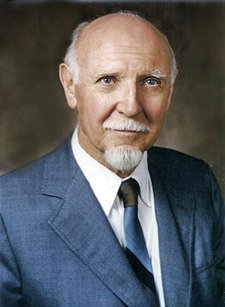Personality Course - Raymond Catell
RAYMOND CATTELL

source
A leader in the development of factor theories, Raymond Cattell claimed that the study of personality passed through two earlier phases before reaching its current scientific status.
“From biblical times until the early nineteenth century,” he wrote, “it was a matter for intuitive insights expressed in the realm of literature”, marked by such giants as Plutarch, Bacon, and Goethe. Then came a century of clinically oriented theorists (Freud, Adler, and Jung), with some experimental work. After that, the study of personality entered the third, “experimental and quantitative,” phase.
BIOGRAPHY
Raymond B. Cattell was born in 1905 in Staffordshire, England, the son and grandson of engineers. In college, Cattell studied science, but dismayed friends by pursuing psychology in graduate school.
He completed his doctoral degree at the University of London (King’s College), at the age of 23.
Prospects for a professorship in psychology were slight, so Cattell accepted an applied position in Leicester and set up a school psychological service. Of these 5 years of clinical work, he later said,
“Though...I felt a charlatan it gave me many leads for personality research” (Cattell, 1984, p. 123).
Besides administrative work, Cattell conducted research in those years. He studied the relationship of intelligence to family size and social status (a research question that offended liberal critics). He developed a projective test at the same time as Henry Murray, who is generally credited for developing this testing strategy.
In 1937 Cattell accepted an invitation to work in social psychology in New York for a year, and remained in the United States permanently. He taught at Clark University and later at Harvard University, where his office was next door to Allport’s. He remarked that “in personality theory, Allport and I spoke a different language, which...was tough on students”.
During World War II, he developed objective personality tests for officer selection.
In 1945, he moved to a research position at the University of Illinois. Freed from teaching responsibilities and with access to a new and (for the times) powerful computer, these were very productive years.
To facilitate distribution of his many new psychological tests, Cattell set up a private organization, the Institute for Personality and Ability Testing (IPAT), in 1949. He founded the Society for Multivariate Experimental Psychology in 1960 to foster the kind of research he felt was necessary to advance personality theory scientifically.
Cattell retired to Hawaii, where he continued to advocate statistical approaches to theory development and to develop computer methods for personality research until his death in 1998. In 1997 he was recognized with an award for lifetime achievement by the American Psychological Association, which praised his work for its inclusion of many areas, saying, “Cattell stands without peer in his creation of a unified theory of individual differences integrating intellectual, temperamental, and dynamic domains of personal- ity in the context of environmental and hereditary influences” (American Psychological Association, 1997).
THE BIG FIVE FACTORS THEORY
The Big Five consist of five broad personality traits: Extraversion, Agreeableness, Neuroticism, Conscientiousness, and Openness.
Each factor has been studied extensively, and each is correlated with many behaviors.The Big Five Factors of Personality Description
Factor - Extraversion (E)
Description of High Scorer - Talkative, Dominant, Sociable
Description of Low Scorer - Quiet, Unfeeling, Passive
Factor - Agreeableness (A)
Description of High Scorer - Good-natured, Soft-hearted, Trusting
Description of Low Scorer - Irritable, Ruthless, Suspicious
Factor - Neuroticism (N)
Description of High Scorer - Emotional, Vulnerable, Anxious
Description of Low Scorer - Calm, Self-controlled, Sense of well-being
Factor - Conscientiousness (C)
Description of High Scorer - Hardworking, Ambitious, Responsible
Description of Low Scorer - Negligent, Lazy, Irresponsible
Factor - Openness (O)
Description of High Scorer - Creative, Imaginative, Prefers variety
Description of Low Scorer - Uncreative, Down-to-earth, Prefers routine
Source: Adapted from McCrae, 1990, p. 402; and McCrae, Costa, & Piedmont, 1993.
Specific Facets of the Big Five Factors of Personality
Factor - Extraversion (E)
Facets - Warmth, Gregariousness, Assertiveness, Activity, Excitement-seeking, Positive emotions
Factor - Agreeableness (A)
Facets - Trust, Straightforwardness, Altruism, Compliance, Modesty, Tender-mindedness
Factor - Neuroticism (N)
Facets - Anxiety, Hostility, Depression, Self-consciousness, Impulsiveness, Vulnerability
Factor - Conscientiousness (C)
Facets - Competence, Order, Dutifulness, Achievement striving, Self-discipline, Deliberation
Factor - Openness (O)
Factors - Fantasy, Aesthetics, Feelings, Actions, Ideas, Values
Note: Each of the five factors is composed of the six facets. The facets are positively correlated with one another, and scores on the facets are summed to obtain a score on the corresponding factor.
Source: Adapted from Costa, McCrae, & Dye, 1991.
IN A NUTSHELL
Cattell’s 16 factor model and the Five Factor theory, use factor analysis to identify the major dimensions of personality description.
- Cattell defined personality simply as “that which permits a prediction of what a person will do in a given situation.”
- Cattell developed a great number of personality tests.
- Cattell’s research obtained data from three sources: self-report questionnaires (Q-data); objective tests, including projective tests and behavioral measures (T-data); and life history information (L-data).
- Cattell used multivariate research methods.
- Cattell described the surface traits of people and, through more intensive statistical analysis, sought the underlying source traits that determine personality.
- Cattell’s 16PF personality test builds on this research and measures the 16 major source traits of personality. These scores can be presented in a profile for each individual.
- A second-order factor analysis of these scores results in five more general factors, including extraversion and anxiety.
- Cattell distinguished various types of traits: dynamic, temperament, and ability.
- Cattell differentiated fluid intelligence (innate potential) from crystallized intelligence (influenced by experience) and developed ways to measure fluid intelligence.
- Cattell’s dynamic lattice presents the relationship among ergs (constitutional dynamic source traits) and metaergs (environmental-mold dynamic source traits), which include sentiments and attitudes.
- These are related according to the principle of subsidiation.
- In principle, behavior can be predicted by the specification equation, which includes traits, situational factors, and temporary factors.
- Although most of his research was nomothetic (R-technique), Cattell also explored a P-technique for idiographic research.
Reference - Theories of Personality - Understanding Persons, Susan Cloninger, The Sage Colleges, 6th edition




Interesting @starjewel. You gave me something to look into a bit more. I love learning, personalities is one of those aspects that intrigue me.
Oh, If you like to learn about pesonality you should read these excerpts that I am publishing here, it will give you a pretty good overall idea about the evolution of theories. I find it fascination for sure. I can forward you some tests you can take to learn more about your own personality. Cool stuff. 😊
@starjewel OHHH so he is the one who came up with the Big Five Factors personality theory (: I have heard of this theory but not the man behind it. Thank you ((':